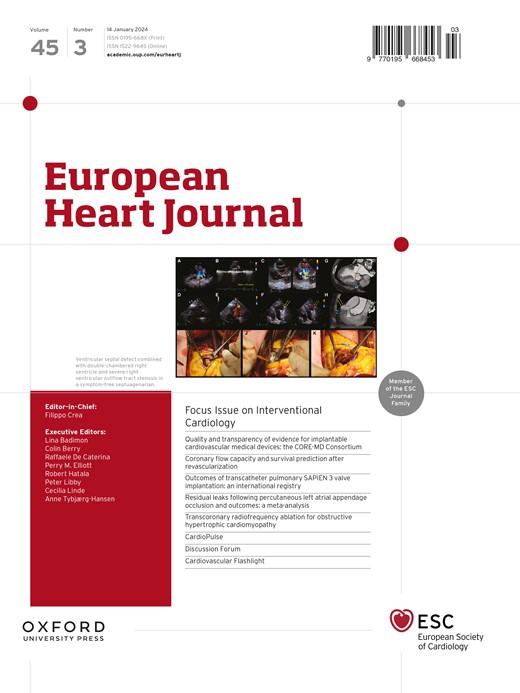Residual cholesterol and inflammatory risk in statin-treated patients undergoing percutaneous coronary intervention†.
IF 37.6
1区 医学
Q1 CARDIAC & CARDIOVASCULAR SYSTEMS
引用次数: 0
Abstract
BACKGROUND AND AIMS Elevated LDL-cholesterol levels and inflammation, as assessed by high-sensitivity C-reactive protein, correlate with cardiovascular risk. However, data on the relative impact of residual LDL-cholesterol and inflammatory risk among statin-treated patients undergoing percutaneous coronary intervention (PCI) is lacking. Hence, this study aimed to investigate the impact of residual cholesterol/inflammatory risk in patients on statin therapy undergoing PCI. METHODS From 2012 to 2022, patients at a tertiary centre undergoing PCI were analysed. Patients were stratified according to LDL-cholesterol (≥70 vs <70 mg/dL) and high-sensitivity C-reactive protein (≥2 vs <2 mg/L) levels: no residual cholesterol or inflammatory risk, residual cholesterol risk, residual inflammatory risk, and combined residual cholesterol and inflammatory risk. Patients presenting with acute myocardial infarction, cancer, no statin treatment at admission, or high-sensitivity C-reactive protein levels >10 mg/L were excluded. The primary endpoint was major adverse cardiovascular events (MACEs), defined as the composite of all-cause mortality, spontaneous myocardial infarction, and stroke 1 year after the index PCI. RESULTS A total of 15 494 patients were included. After 1-year follow-up, individuals with isolated residual inflammatory risk had the highest MACE rate (5.1%), followed by patients with combined cholesterol and inflammatory risk, no residual risk, and isolated residual cholesterol risk. After multivariable Cox regression analysis, patients with residual inflammatory risk had a 1.8-fold higher risk for MACE (adjusted hazard ratio: 1.78, 95% confidence interval 1.36-2.33, P < .001) compared with those with no residual cholesterol or inflammatory risk. This was similar in patients with combined residual cholesterol and inflammatory risk (adjusted hazard ratio: 1.56, 95% confidence interval 1.19-2.04, P = 0.001). Of note, no independent association of isolated residual cholesterol risk (adjusted hazard ratio: 1.01, 95% confidence interval .76-1.35, P-value = .920) with MACE was noted (P-trend across all groups <.001). CONCLUSIONS Among statin-treated patients undergoing PCI, residual inflammation but not cholesterol risk was associated with an increased risk of MACE during follow-up.经皮冠状动脉介入治疗的他汀类药物治疗患者的残留胆固醇和炎症风险
背景和目的:根据高敏感性c反应蛋白评估,ldl -胆固醇水平升高和炎症与心血管风险相关。然而,在接受他汀类药物治疗的经皮冠状动脉介入治疗(PCI)的患者中,残留ldl -胆固醇和炎症风险的相对影响数据缺乏。因此,本研究旨在探讨PCI患者残留胆固醇/炎症风险对他汀类药物治疗的影响。方法对2012年至2022年在某三级中心行PCI的患者进行分析。根据低密度脂蛋白胆固醇(≥70 vs 10 mg/L)对患者进行分层。主要终点是主要不良心血管事件(mace),定义为全因死亡率、自发性心肌梗死和PCI指数后1年卒中的综合。结果共纳入15 494例患者。随访1年后,孤立性残留炎症风险患者的MACE率最高(5.1%),其次是胆固醇和炎症合并风险患者、无残留风险患者和孤立性残留胆固醇风险患者。多变量Cox回归分析显示,有残余炎症风险的患者发生MACE的风险是无残余胆固醇或炎症风险患者的1.8倍(校正风险比为1.78,95%可信区间为1.36-2.33,P < 0.001)。这与合并残余胆固醇和炎症风险的患者相似(校正风险比:1.56,95%可信区间1.19-2.04,P = 0.001)。值得注意的是,没有发现孤立残余胆固醇风险(校正风险比:1.01,95%可信区间为0.76 -1.35,p值= 0.920)与MACE之间的独立关联(所有组的p趋势均< 0.001)。结论:在接受他汀类药物治疗的PCI患者中,随访期间,残余炎症与MACE风险增加相关,而胆固醇风险与MACE风险无关。
本文章由计算机程序翻译,如有差异,请以英文原文为准。
求助全文
约1分钟内获得全文
求助全文
来源期刊

European Heart Journal
医学-心血管系统
CiteScore
39.30
自引率
6.90%
发文量
3942
审稿时长
1 months
期刊介绍:
The European Heart Journal is a renowned international journal that focuses on cardiovascular medicine. It is published weekly and is the official journal of the European Society of Cardiology. This peer-reviewed journal is committed to publishing high-quality clinical and scientific material pertaining to all aspects of cardiovascular medicine. It covers a diverse range of topics including research findings, technical evaluations, and reviews. Moreover, the journal serves as a platform for the exchange of information and discussions on various aspects of cardiovascular medicine, including educational matters.
In addition to original papers on cardiovascular medicine and surgery, the European Heart Journal also presents reviews, clinical perspectives, ESC Guidelines, and editorial articles that highlight recent advancements in cardiology. Additionally, the journal actively encourages readers to share their thoughts and opinions through correspondence.
 求助内容:
求助内容: 应助结果提醒方式:
应助结果提醒方式:


